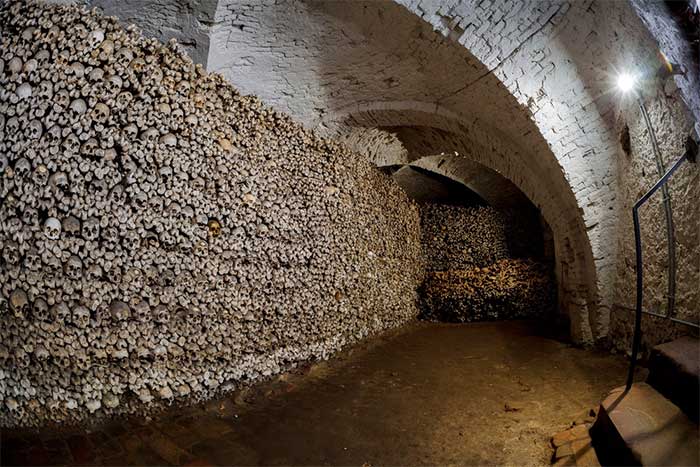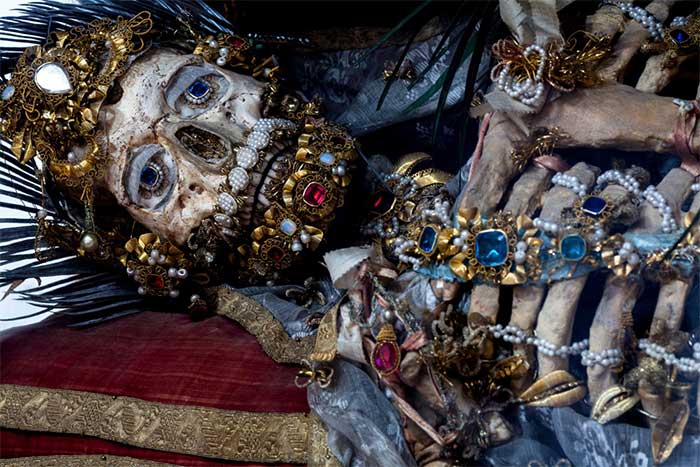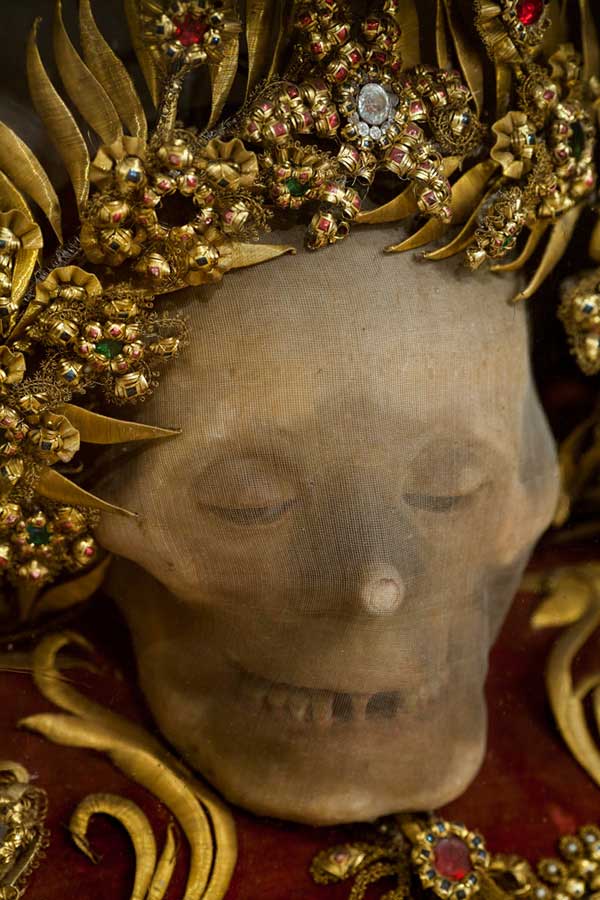Mysterious about the jewel encrusted skeleton
Historian and photographer American - Paul Koudounaris , also known as hunters relics "Indiana Bones" - has released a collection of photos of the skeleton ancient jeweled ivory, jewels are discovered in churches in Europe. Many people are skeptical about the origin, authenticity, as well as the stories behind these skeletons.

Bone cave in Oppenheim - Germany surprised many people. (Photo: Paul Koudounaris).
According to Wired, Koudounaris was once told by a man about a skeleton encrusted with jewels while in East Germany, and his curiosity immediately prompted him to explore. And then, American historian has found and photographed a lot of skeleton wearing jewelry throughout the churches of Europe. These skeletons date back more than 400 years and are hidden in mysterious religious facilities. Taking pictures of these skeletons is also not easy because of the difficulty in excavation.

The skeleton of St. Albertus. (Photo: Paul Koudounaris).
In an interview with CNN, Koudounaris talked about why they decorated the skeleton with jewelry: ' Behind the bones is an important message: these are transported north and then decorated in an elaborate and luxurious manner, as if to convey the message that the greatest glory is given to those who remain faithful to the faith and are willing to sacrifice in the end for that faith . "
These skeletons have been taken to churches and monasteries for public display to arouse religious pride. The monks take care of the skeleton, they even donate their own ring to contribute to the decoration of the skeleton. Koudounaris said he agrees with the display plan when everyone can admire them and donate for the purpose of preserving the skeletons.

Decorative skulls found in Heiligkreuztal - Germany. (Photo: Paul Koudounaris).

The skeleton of St. Luciana. (Photo: Paul Koudounaris).
One of the published skeletons took up to five years to decorate and was found in coffins locked in ancient catacombs. In addition, thousands of other skeletons were unearthed from Roman catacombs in the 16th century. These skeletons are scattered in several towns in Germany, Austria, and Switzerland at the request of the church. Vatican. The authorities then sent them to Catholic churches and chapels to replace relics destroyed during the Protestant Reformation in the 1500s.

The skeleton of Saint Valentinus. (Photo: Paul Koudounaris).
These treasured sacred remains are also called Catacomb Saints . The amount of pure gold and silver jewelry is worth thousands of dollars. After being decorated, the remains are displayed in the alcove of the church.

The skeleton of Saint Deodatus. (Photo: Paul Koudounaris).
One of the most interesting discoveries of Paul Koudounaris is the skeleton of St. Deodatus was found in Moosburg, Germany, the skeleton still has the pearls on it. He could not hide his joy: "The church allowed me to take the skeleton out of the box, it was really an indescribable feeling, it seemed that there was a bond of cohesion and fate that allowed me to meet him. things after 2 centuries. '
There are still many mysteries about these ivory-encrusted skeletons, many of whom would love to see them. These priceless skeletons are considered a symbol of the newly found power of the Catholic Church in areas formerly Protestant.
- Long skulls like aliens encrusted with gems in their teeth
- The mysterious 'no piercing' of 3500 year old jewel
- Mysterious 'monster' skeleton in Russia
- Cat's eye jewel formed from ancient dinosaur bones in Australia
- The mysterious 'alien skeleton' is decoded
- Discovering the portrait of gold encrusted angel where Jesus was born
- The 1,300-year-old twisted skeleton made the archeology confused
- The mysterious skeleton carries the leather boots on the bottom of the River Thames
- Mysterious skeleton of the alien planet washed up on the English coast
- Discovered a 3,500-year-old male and female skeleton in the fist position
- Discover the mysterious Maya queen's skeleton
- Mysterious 1000-year-old jaw bone on the beach
 The truth about the mysterious red-haired giant at Lovelock Cave
The truth about the mysterious red-haired giant at Lovelock Cave Inunaki Tunnel: The haunted road leading into Japan's 'village of death'
Inunaki Tunnel: The haunted road leading into Japan's 'village of death' The mystery of the phenomenon of human reflection before dying
The mystery of the phenomenon of human reflection before dying 6 mysterious phenomena, although science has been developed for a long time, still cannot be answered
6 mysterious phenomena, although science has been developed for a long time, still cannot be answered